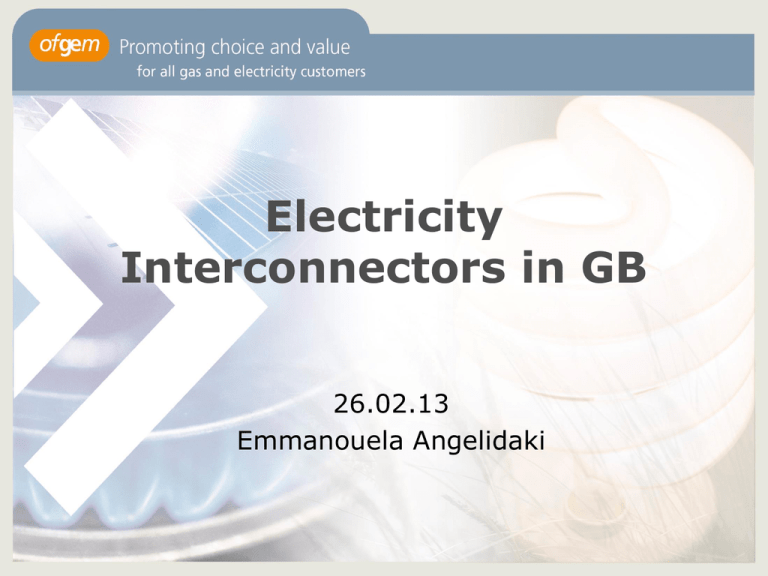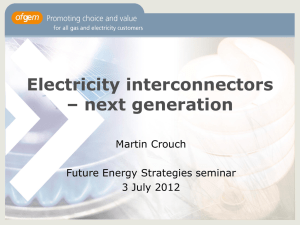Proposed approach for setting the cap and floor returns
advertisement

Electricity Interconnectors in GB 26.02.13 Emmanouela Angelidaki Content • Role of interconnection in Europe and GB • Approach to interconnector investment to date and drivers for change • New regulatory regime for interconnector investment in GB • Next Steps • Q&A 2 Interconnection-the basics • Interconnection (IC) =Cross border transmission, connecting different member states • European legislation: leading role on how revenues are raised (i.e. Profits can be made) • It requires all interconnector capacity to be allocated via market based methods, i.e. Auctions • Interconnectors generate revenue based on the price arbitrage opportunity between countries. Whilst there is a country price difference, there will be demand for the capacity & a revenue stream will be generated • In GB, to date, investment could take place only through the merchant route, i.e. investors would take the full upside and downside risk and would seek for an exemption from EU legislation , to protect their business case; • We are now developing a regulatory regime which can facilitate economic investment … 3 European Energy Infrastructure Package: Interconnection capacity to support 2020 RES targets 2020 (Source: Imperial College & KEMA, study for EIP communication, 2010) 4 ECF 2050 Pathways: Interconnection capacity to support 80% RES by 2050 2050 Source: ECF – Roadmap to 2050 (www.roadmap2050.eu) 5 Interconnection from Great Britain: the context 2012 figure: 4.8% Average total import capacity relative to installed generation capacity by percentage, 2004 (Source, DG Competition Report on Energy Sector Inquiry, 2007) 6 Proposed electricity interconnector investment 7 Drivers for change • Increasing government support for IC investment and Ofgem’s commitment to facilitate economic and efficient IC investment, while maintaining the developer-led approach • Potential for commercially viable interconnection – But pure merchant financing of projects less viable … – We want to see timely development of new infrastructure to contribute to the delivery of internal energy market • Financing gap- greater need for 3rd party investment? • Need for a common / coordinated approach to regulation of shared assets • Challenges with merchant-exempt regime: – Regulated “risk” of exemptions, which are seen as the exception not the rule – European model, national TSOs deliver interconnector investment Need to develop a regulatory regime to remove regulatory barriers and facilitate economic and efficient investment 8 Steps to date • January 2010: Consultation on options for regulating interconnector investment • September 2010: Next steps letter on our intention to progress with the cap and floor regime, using project NEMO as the pilot project • June 2011: Consultation on principles and design of the cap and floor regime, exploring whether this regime could be a high level solution for other IC projects • December 2011: Preliminary conclusions on the principles and design & Ofgem’s intention to develop a process for considering other IC investment proposals and to ensure the three GB regimes for transmission investment are compatible (offshore, onshore, interconnection) 9 CAP AND FLOOR APPROACH • • • • • • Recoup returns within bounds of pre set cap and floor Revenues over cap – paid back to consumers Revenues fall below floor – triggers payment from consumers Allows revenue regulation, protects consumers from market power Maintains element of market valuation of interconnection Within the regulated regime favoured by Third Package 10 CAP AND FLOOR APPROACH 11 Timeplan for NEMO Phase 1 (Investment decision): Provisional decision on C&F levels based opex &capex forecasts 2013-2014 Phase 2 Phase 3 (Construction): ( Postconstruction): NRAs receive all bids and justification for preferred bid Ex-post review of actual capex & reforecast of opex; final C&F levels 25 year regime, revenues assessed against C&F every 5 years 2017-2018 2018 2014-2017 Phase 4(operation): 12 Proposed approach for setting the cap and floor returns • Will be set out in our consultation, expected to be published in March • Aim: identify risks associated with IC investment and then develop an approach for setting the CoC for IC investment under the cap and floor approach; • The proposed approach is developed for a notionally efficient investment structure and it aims to answer questions like: – Separate CoC at the cap and the floor vs. single CoC central estimate for the project; – Mechanistic vs. Discretionary approach – CoC parameters fixed at financial close vs. post construction – Cross Jurisdiction considerations: blended CoC vs. Separate calculation in each currency 13 Next Steps • Consultation on our proposed regime, including the CoC methodology: March 2013- May 2013 • Analysis of responses and review of design and methodology: June-September 2013 • Decision on NEMO provisional cap and floor returns: Q4 2013 14 15 Regime Design Aspect Design Mechanism Cap & floor returns earned within boundaries; revenues above cap returned to consumers, revenues below floor require payment from consumers (via Transmission Use of System Charges) Regime length 20-25 years Cap and floor levels Levels set ex-ante and remain fixed for regime length Set on basis of costs, using RAV based model Setting costs Capex – ex post capex review* Opex – set ex-ante, ie before operation Cap and floor profile Flat in real terms Assessment period (assessing whether IC revenues are above/below cap/floor) 5 years, discrete periodic basis Availability incentive Symmetric financial incentive linked to the cap, based on actual vs. target availability, target set on a project by project basis *(for NEMO; consultation will explore alternative treatment for future projects) 16







